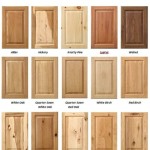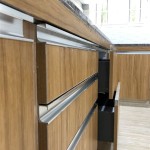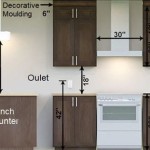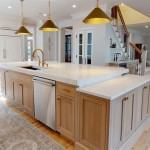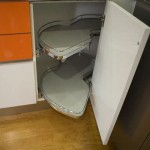Multi-Colored Kitchen Cabinet Ideas: A Comprehensive Guide
The kitchen, often considered the heart of the home, is a space where functionality meets aesthetics. Kitchen cabinets, as a dominant visual element, play a crucial role in defining the overall atmosphere. While monochromatic schemes have been a popular choice for years, the trend of multi-colored kitchen cabinets is gaining momentum, allowing homeowners to express their individuality and create a more dynamic and visually appealing space. This article explores various ideas and considerations for incorporating multi-colored cabinets into kitchen design.
Employing multiple colors within kitchen cabinetry can range from subtle variations to bold contrasts. The approach chosen will largely depend on the desired aesthetic, kitchen size, existing architectural features, and personal preferences. Effective implementation requires careful planning and consideration of color theory, materials, and hardware.
Understanding the Benefits of Multi-Colored Cabinets
Multi-colored cabinets offer several advantages over a single-color scheme. Firstly, they allow for greater personalization. Homeowners can select colors that reflect their unique style and create a kitchen that feels truly their own. Secondly, multi-colored cabinets can visually break up a large kitchen, preventing it from feeling monolithic or overwhelming. By strategically using different colors, specific areas can be highlighted or receded, influencing the perceived size and shape of the room. Thirdly, this approach can effectively accentuate architectural details. For example, painting an island a different color than the surrounding cabinetry can draw attention to its unique design and make it a focal point.
Furthermore, incorporating multiple colors provides an opportunity to introduce visual interest and depth. A well-planned color palette can add vibrancy and energy to a space, transforming a utilitarian kitchen into a welcoming and engaging environment. The strategic use of color can also influence mood and perception. Warm tones can create a sense of coziness and comfort, while cool tones can evoke a feeling of calmness and serenity.
Finally, employing different colors on cabinets can serve a practical purpose by delineating different functional zones within the kitchen. For instance, cabinets around the cooking area might be a darker, more durable color to conceal splatters and stains, while cabinets in the pantry area could be a lighter, more refreshing color.
Exploring Different Multi-Colored Cabinet Schemes
Several approaches can be taken when designing a kitchen with multi-colored cabinets, each offering a distinct aesthetic and visual impact. One popular scheme involves using two complementary colors. These are colors that sit opposite each other on the color wheel, such as blue and orange, or red and green. When used together, complementary colors create a vibrant and dynamic contrast. However, it's crucial to use them in balanced proportions to avoid overwhelming the space. Often, one color is used as the dominant hue, while the other serves as an accent.
Another common approach is to employ analogous colors. These are colors that are adjacent to each other on the color wheel, such as blue, blue-green, and green. Analogous color schemes are generally more harmonious and less visually jarring than complementary schemes. They create a sense of unity and flow within the kitchen. This approach is particularly suitable for smaller kitchens where a sense of spaciousness is desired.
A gradient effect can also be achieved by using different shades of the same color. This creates a subtle and sophisticated look, adding depth and dimension to the cabinetry. For example, the lower cabinets could be a darker shade of gray, while the upper cabinets are a lighter shade. This approach is particularly effective in modern and contemporary kitchens.
Another bold option is to use a triadic color scheme, which involves three colors evenly spaced on the color wheel, such as red, yellow, and blue. This approach creates a vibrant and playful atmosphere. However, it's essential to use triadic colors sparingly and to ground them with neutral tones to prevent the kitchen from feeling chaotic.
Finally, the two-toned kitchen remains a popular choice. This typically involves using one color for the upper cabinets and another color for the lower cabinets or the kitchen island. Often, a lighter color is used for the upper cabinets to create a sense of airiness and openness, while a darker color is used for the lower cabinets to ground the space and provide a sense of stability.
Practical Considerations for Implementing Multi-Colored Cabinets
Successfully implementing multi-colored kitchen cabinets requires careful planning and attention to detail. Firstly, consider the existing architectural features of the kitchen. The color scheme should complement the flooring, countertops, backsplash, and other elements in the room. For example, if the kitchen has a natural stone countertop with warm undertones, it's best to choose cabinet colors that also have warm undertones.
Secondly, take into account the size and layout of the kitchen. In a small kitchen, it's generally best to avoid dark and saturated colors, as they can make the space feel even smaller. Lighter and more neutral colors will help to create a sense of spaciousness. In a large kitchen, bolder colors can be used to create visual interest and define different zones. The layout of the cabinets should also be considered. For example, if the upper cabinets are significantly larger than the lower cabinets, it might be best to use a lighter color on the upper cabinets to prevent them from overpowering the space.
Thirdly, the style of the kitchen should be taken into consideration. In a traditional kitchen, classic color combinations such as cream and gray or navy and white might be appropriate. In a modern kitchen, bolder and more unconventional color combinations can be used. The choice of hardware, such as knobs and pulls, should also complement the color scheme. For example, brass hardware might look stunning with navy blue cabinets, while stainless steel hardware might be a better choice for gray cabinets.
Fourthly, consider the lighting in the kitchen. Natural light can significantly impact the appearance of colors. Before making any final decisions, it's essential to test the chosen colors in the kitchen under different lighting conditions. Artificial lighting can also influence color perception. Warm white light can enhance warm colors, while cool white light can enhance cool colors.
Fifthly, the budget should be taken into account. Painting or refinishing existing cabinets is generally a more cost-effective option than replacing them. However, the quality of the paint and the skill of the painter can significantly impact the final result. If new cabinets are being installed, the cost can vary depending on the materials, style, and finish. Custom cabinets are generally more expensive than stock cabinets, but they offer greater flexibility in terms of design and color options.
Sixthly, maintenance should be considered. Darker colors tend to show dust and fingerprints more readily than lighter colors. Consider this when choosing colors, especially for high-traffic areas. A durable and easy-to-clean finish is also crucial for kitchen cabinets. Semi-gloss or gloss finishes are generally more resistant to staining and easier to wipe down than matte finishes.
Finally, consult with a professional kitchen designer. A designer can provide expert advice on color selection, layout, and materials, ensuring that the final result is both aesthetically pleasing and functional. They can also help to create a cohesive design that integrates the multi-colored cabinets with the rest of the kitchen.
Examples of Successful Multi-Colored Kitchens
Numerous examples showcase the successful implementation of multi-colored kitchen cabinets. One prominent example involves a kitchen with white upper cabinets and navy blue lower cabinets. This classic combination creates a timeless and elegant look. The white upper cabinets create a sense of airiness, while the navy blue lower cabinets ground the space and add a touch of sophistication. Brass hardware and white marble countertops further enhance the luxurious feel of the kitchen.
Another example features a kitchen with light gray upper cabinets and dark gray lower cabinets. This monochromatic scheme creates a subtle and sophisticated look. The different shades of gray add depth and dimension to the cabinetry, while the stainless steel appliances and hardware complement the overall aesthetic. This approach is particularly suitable for modern and contemporary kitchens.
A third example showcases a kitchen with a white island and green perimeter cabinets. The green cabinets add a pop of color and create a focal point in the room. The white island provides a neutral backdrop and prevents the green from overwhelming the space. This approach is particularly effective in kitchens with natural light and greenery outside the windows.
A fourth example depicts a kitchen with red lower cabinets and yellow upper cabinets. This bold and playful combination creates a vibrant and energetic atmosphere. The red and yellow colors are balanced by white countertops and a neutral backsplash. This approach is particularly suitable for homeowners who want to express their individuality and create a truly unique kitchen.
A fifth example illustrates a kitchen with natural wood lower cabinets and painted white upper cabinets. This combination offers a warm and inviting aesthetic. The natural wood adds texture and warmth to the space, while the white upper cabinets create a sense of brightness. This approach is particularly suitable for farmhouse and rustic-style kitchens.
Key Takeaways for Multi-Colored Cabinet Design
Successfully incorporating multi-colored cabinets into a kitchen design requires careful planning and consideration. By understanding the benefits of this approach, exploring different color schemes, and taking into account practical considerations, homeowners can create a kitchen that is both visually appealing and functional. Consulting with a professional designer can further enhance the outcome, ensuring a cohesive and harmonious design that reflects personal style and preferences.
Strategic Placement and Color Division
The placement of colors within a multi-colored kitchen cabinet design is just as important as the color choices themselves. Consider the visual weight of each color. Darker colors tend to appear heavier and can ground a space, while lighter colors feel more airy and open. Distributing these colors strategically can dramatically impact the perceived size and balance of the kitchen.
For example, in a kitchen with standard height ceilings, using a lighter color on the upper cabinets can visually lift the ceiling and create a sense of height. Conversely, darker lower cabinets can ground the space and provide a solid foundation. The division of colors can also be used to highlight specific areas or features. An island, for example, can be painted a contrasting color to make it a focal point and define the work zone.

18 Examples Of Two Toned Kitchen Cabinets From Designers

Design Inspiration Tips For Two Tone Kitchen Cabinets Hirshfield S

Design Inspiration Tips For Two Tone Kitchen Cabinets Hirshfield S

Follow The Trend Color Blocking Marsh Cabinets

93 Bright And Colorful Kitchen Design Ideas Digsdigs
:strip_icc()/goldalamodetwotoned-7898e45ce4004aec878721b187b98301.jpeg?strip=all)
30 Stylish Two Toned Kitchen Ideas From An Expert

Multi Colored Cabinets In Kitchen Makes Your Life Colorful
:strip_icc()/cdn.cliqueinc.com__cache__posts__250323__two-toned-kitchen-cabinets-250323-1519416360278-main.700x0c-053dda2f27cc41c18d2f5d3aaef8660b-22a98f743a9e480ab9869a2e5cf6d3a0.jpg?strip=all)
30 Stylish Two Toned Kitchen Ideas From An Expert

10 Popular Usage Of Kitchen Cabinets Savona Bath

69 Stylish Kitchen Cabinet Ideas 2025
Related Posts



